-
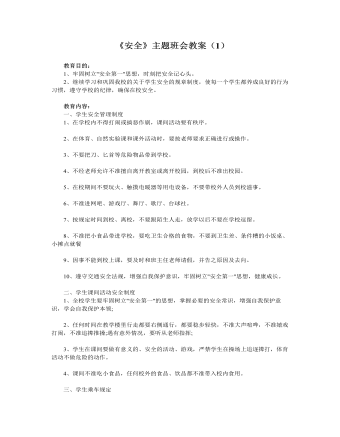
《安全》主题班会教案(1)
教育内容:一、学生安全管理制度1、在学校内不得打闹或搞恶作剧,课间活动要有秩序。2、在体育、自然实验课和课外活动时,要按老师要求正确进行或操作。3、不要把刀、匕首等危险物品带到学校。4、不经老师允许不准擅自离开教室或离开校园,到校后不准出校园。5、在校期间不要玩火、触摸电暖器等用电设备,不要带校外人员到校滋事。6、不准进网吧、游戏厅、舞厅、歌厅、台球社。7、按规定时间到校、离校,不要跟陌生人走,放学以后不要在学校逗留。8、不准把小食品带进学校,要吃卫生合格的食物,不要到卫生差、条件糟的小饭桌、小摊点就餐9、因事不能到校上课,要及时和班主任老师请假,并告之原因及去向。10、遵守交通安全法规,增强自我保护意识,牢固树立"安全第一"思想,健康成长。
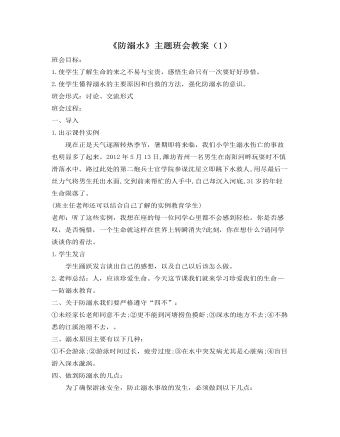
《防溺水》主题班会教案(1)
班会目标: 1.使学生了解生命的来之不易与宝贵,感悟生命只有一次要好好珍惜。 2.使学生懂得溺水的主要原因和自救的方法,强化防溺水的意识。 班会形式:讨论、交流形式 班会过程: 一、导入 1.出示课件实例 现在正是天气逐渐转热季节,暑期即将来临,我们小学生溺水伤亡的事故也明显多了起来。2012年5月13日,潍坊青州一名男生在南阳河畔玩耍时不慎滑落水中。路过此处的第二炮兵士官学院参谋沈星立即跳下水救人,用尽最后一丝力气将男生托出水面,交到前来帮忙的人手中,自己却沉入河底,31岁的年轻生命陨落了。 (班主任老师还可以结合自己了解的实例教育学生) 老师:听了这些实例,我想在座的每一位同学心里都不会感到轻松。你是否感叹,是否惋惜,一个生命就这样在世界上转瞬消失?此刻,你在想什么?请同学谈谈你的看法。
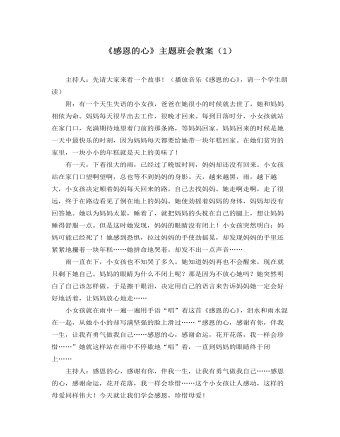
《感恩的心》主题班会教案(1)
主持人:然而我们又是怎样对待我们的父母的呢?下面我们来做个调查?你是否了解你的妈妈?1、你妈妈的生日是_________。2、你妈妈的体重是_________。3、你妈妈的身高是________。4、你妈妈穿_______码鞋。5、你妈妈喜欢颜色是________。6、你妈妈喜欢水果是________。7、你妈妈喜欢的花是________。8、你妈妈喜欢的日常消遣活动是_____________。请你如实回答。把你的答案写在一张纸寄给你妈妈评分答对6题以下的请你以后多与妈妈沟通。主持人:其实值得感恩的不仅仅我们的母亲,我们对父亲、师长、亲朋、同学、社会等等都应始终抱有感恩之心。我们的生命、健康、财富以及我们每天享受着的空气阳光水源,都应该在我们的感恩之列。一位盲人曾经请人在自己的乞讨用的牌子上这样写道:“春天来了,而我却看不到她。”我们与这位盲人相比,进一步说与那些失去生命和自由的人相比,目前能这样快快乐乐地活在世界上,谁说不是一种命运的恩赐,我们还会时常愤怒得发抖而总去抱怨命运给自己的不幸和不平吗?
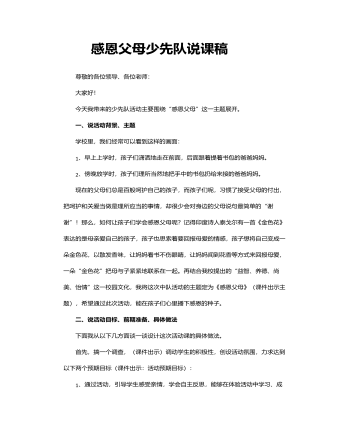
感恩父母说课稿(1)
紧接着分享爱的故事,(课件出示故事)主持人引导队员们谈谈自己的感受,进一步感悟父母亲为自己十几年如一日的付出,从来不求回报,并且在最为难得时刻,将生的希望留给孩子,让队员们感受父母那深深的爱。接下来出示英语单词mother,并且解释这个单词的含义。(课件出示)这时进入一个互动环节《回到小时候》,组织全体队员一起轻轻地低下头,闭上眼睛,搜索记忆,回忆从小到大父母给予的点点滴滴。2分钟后先在小组中分享,再集体交流。在接下来大家一块分享文章《奇迹的名字叫父亲》(课件出示)让孩子们在一次感受为了孩子,亲爱的父亲创造了医学史上的奇迹。让队员们谈一谈自己的感受。这样4个活动,层层递进,逐步深入,既让队员们重新认识了身边最最普通的父母之爱,又在心里激起了层层涟漪,激发了队员的感恩意识。
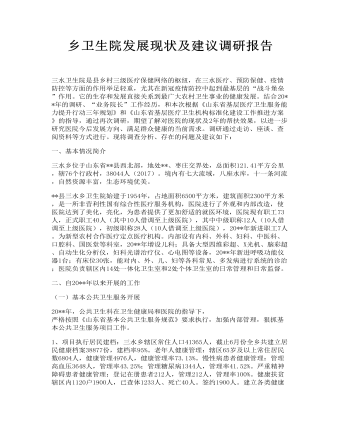
乡卫生院发展现状及建议调研报告
1、项目执行居民建档:三水乡辖区常住人口41365人,截止6月份全乡共建立居民健康档案38877份,建档率95%。老年人健康管理:辖区65岁及以上常住居民数6804人,健康管理4976人,健康管理率73.13%。慢性病患者健康管理:管理高血压3648人,管理率43.25%;管理糖尿病1344人,管理率41.52%。严重精神障碍患者健康管理:登记在册患者212人,管理212人,管理率100%。健康扶贫 辖区内1120户1900人,已查体1233人、死亡40人。签约1900人。建立各类健康扶贫工作台账,并制定外出人员查体销号工作台账随时来院健康查体后逐一销号。

人教版高中地理选修2三峡工程对生态环境和名胜古迹的影响及对策教案
一、三峡工程的生态环境效应三峡工程的生态环境效应是指建设三峡工程对生态与环境的有利和不利影响。1、有利影响(1)防洪:(2)防治血吸虫病:(3)减轻洞庭湖淤积(4)增加枯水期流量,改善水(5)调节局部气候:(6)减轻环境污染:综上所述,三峡工程对生态环境的有利影响主要在中下游。2、不利影响及措施(1)淹没土地、耕地:水库蓄水将淹没土地、耕地。(2)加剧水土流失和环境污染:在移民开发和城市迁建过程中,处理不当可能产生新的水土流失和环境污染等问题。(3)诱发地质灾害(地震、滑坡):水库蓄水改变了原有地应力的平衡,可能诱发地震,并使库岸发生滑坡等地质灾害的可能性增大。(4)加重泥沙淤积:水库蓄水,使库区水流速度变慢,库区和库尾的泥沙淤积加重。
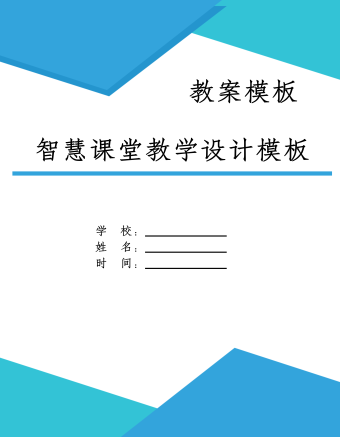
分式方程的解法及应用教学设计与学案
内容:分式方程的解法及应用——初三中考数学第一轮复习学习目标:1、熟练利用去分母化分式方程为整式方程2、熟练利用分式方程的解法解决含参数的分式方程的问题重点:分式方程的解法(尤其要理解“验”的重要性)难点:含参数的分式方程问题预习内容:1、观看《分式方程的解法》《含参数分式方程增根问题》《解含参分式方程》视频2、完成预习检测

初中数学浙教版七年级下册《第二章 二元一次方程组 三元一次方程组及其解法》教材教案
知识与技能目标:1. 能正确说出三元一次方程(组)及其解的概念,能正确判别一组数是否是三元一次方程(组)的解;2. 会根据实际问题列出简单的三元一次方程或三元一次方程组。过程与方法目标:1. 通过加深对概念的理解,提高对“元”和“次”的认识。2. 能够逐步培养类比分析和归纳概括的能力,了解辩证统一的思想。情感态度与价值观目标:通过对实际问题的分析,使学生进一步体会方程是刻画现实世界的有效数学模型,培养学生良好的数学应用意识。

北师大初中数学九年级上册营销问题及平均变化率问题与一元二次方程2教案
5.一件上衣原价每件500元,第一次降价后,销售甚慢,第二次大幅度降价的百分率是第一次的2 倍,结果以每件240元的价格迅速出售,求每次降价的百分率是多少?6.水果店花1500元进了一批水果,按50%的利润定价,无人购买.决定打折出售,但仍无人购买,结果又一次打折后才售完.经结算,这批水果共盈利500元.若两次打折相同,每次打了几折?(精确到0.1折)7.某服装厂为学校艺术团生产一批演出服,总成本3000元,售价每套30元.有24名家庭贫困学生免费供应.经核算,这24套演出服的成本正好是原定生产这批演出服的利润.这批演出服共生产了多少套?8、某商店经营T恤衫,已知成批购进时单价是2.5元。根据市场调查,销售量与销售单价满足如下关系:在一段时间内,单价是13.5元时,销售量是500件,而单价每降低1元,就可以多售200件。请你帮助分析,销售单价是多少时 ,可以获利9100元?
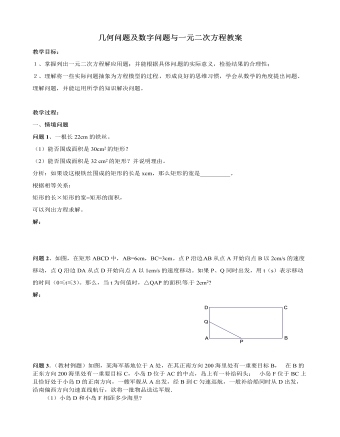
北师大初中数学九年级上册几何问题及数字问题与一元二次方程2教案
三、课后自测:1、如图,A、B、C、D为矩形的四个顶点,AB=16cm,BC= 6cm,动点P、 Q分别从点A、C出发,点P以3cm/s的速度向点B移动,一直到达B为止;点Q以2cm/s的速度向点D移动。经过多长时间P、Q两点之间的距离是10cm?2、如图,在Rt △ABC中,AB=BC=12cm,点D从点A开始沿边AB以2cm/s的速度向点B移动,移 动过程中始终保持DE∥BC,DF∥AC,问点D出发几秒后四边形DFCE的面积为20cm2?3、如图所示,人民海关缉私巡逻艇在东海海域执行巡逻任务时,发现在其所处的位置 O点的正北方向10海里外的A点有一涉嫌走私船只正以24海里/时的速度向正东方向航行,为迅速实施检查,巡逻艇调整好航向,以26海里/时的速度追赶。在涉嫌船只不改变航向和航速的前提下,问需要几小时才 能追上( 点B为追上时的位置)?
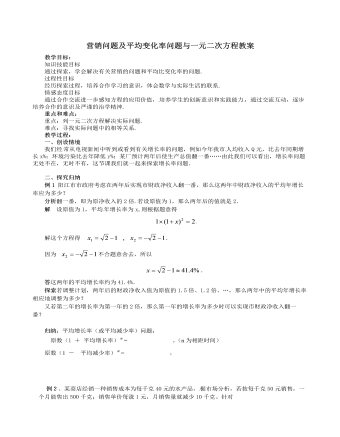
北师大初中数学九年级上册营销问题及平均变化率问题与一元二次方程2教案
5.一件上衣原价每件500元,第一次降价后,销售甚慢,第二次大幅度降价的百分率是第一次的2 倍,结果以每件240元的价格迅速出售,求每次降价的百分率是多少?6.水果店花1500元进了一批水果,按50%的利润定价,无人购买.决定打折出售,但仍无人购买,结果又一次打折后才售完.经结算,这批水果共盈利500元.若两次打折相同,每次打了几折?(精确到0.1折)7.某服装厂为学校艺术团生产一批演出服,总成本3000元,售价每套30元.有24名家庭贫困学生免费供应.经核算,这24套演出服的成本正好是原定生产这批演出服的利润.这批演出服共生产了多少套?8、某商店经营T恤衫,已知成批购进时单价是2.5元。根据市场调查,销售量与销售单价满足如下关系:在一段时间内,单价是13.5元时,销售量是500件,而单价每降低1元,就可以多售200件。请你帮助分析,销售单价是多少时 ,可以获利9100元?
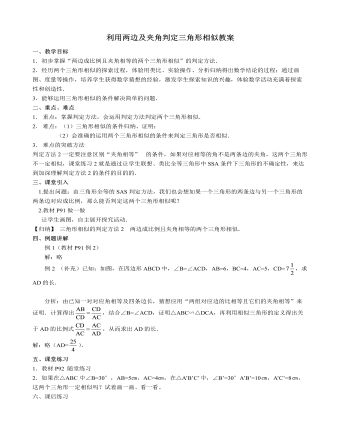
北师大初中数学九年级上册利用两边及夹角判定三角形相似2教案
一、教学目标1.初步掌握“两边成比例且夹角相等的两个三角形相似”的判定方法.2.经历两个三角形相似的探索过程,体验用类比、实验操作、分析归纳得出数学结论的过程;通过画图、度量等操作,培养学生获得数学猜想的经验,激发学生探索知识的兴趣,体验数学活动充满着探索性和创造性.3.能够运用三角形相似的条件解决简单的问题. 二、重点、难点1. 重点:掌握判定方法,会运用判定方法判定两个三角形相似.2. 难点:(1)三角形相似的条件归纳、证明;(2)会准确的运用两个三角形相似的条件来判定三角形是否相似.3. 难点的突破方法判定方法2一定要注意区别“夹角相等” 的条件,如果对应相等的角不是两条边的夹角,这两个三角形不一定相似,课堂练习2就是通过让学生联想、类比全等三角形中SSA条件下三角形的不确定性,来达到加深理解判定方法2的条件的目的的.

人教版高中地理必修1第一章第四节地球的圈层结构说课稿
(一)教材的地位与作用本节教材主要从两个方面阐述课程标准:第一是地球的内部圈层,要求能够说出地球内部圈层主要包括地壳、地幔和地核;第二是地球的外部圈层,包括大气圈、水圈和生物圈;还有介于内部和外部圈层之间的一个圈层,包括地壳和上地幔顶部,即软流层之上的固体岩石部分。本条标准有显性和隐性两方面的要求,显性要求是从宏观上了解地球结构的特点,隐性要求是了解自然环境的组成。在宏观了解地球圈层结构的基础上认识自然环境的组成,即在空间范围上把自然环境放在地球圈层结构中认识。但是对于各圈层不要求展开深入了解,而应抓其主要特点及与人类活动关系密切的内容。(二)教学目标(1)知识与技能目标:1.了解地球圈层结构及特点,知道地球内部圈层的组成及其划分依据;2.尝试根据地震波划分地球内部圈层,并能概括出各圈层的主要特点;3.运用图表了解地球表层的含义。
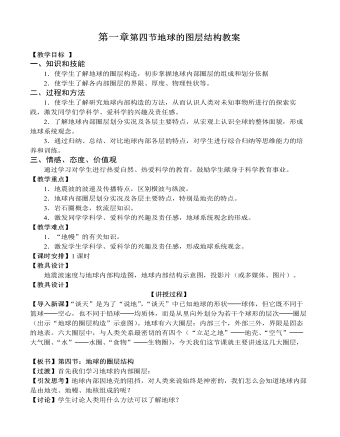
人教版高中地理必修1第一章第四节地球的图层结构教案
一、知识和技能1.使学生了解地球的圈层构造,初步掌握地球内部圈层的组成和划分依据2.使学生了解各内部圈层的界限、厚度、物理性状等。二、过程和方法1.使学生了解研究地球内部构造的方法,从而认识人类对未知事物所进行的探索实践,激发同学们学科学、爱科学的兴趣及责任感。2.了解地球内部圈层划分实况及各层主要特点,从宏观上认识全球的整体面貌,形成地球系统观念。3.通过归纳、总结、对比地球内部各层的特点,对学生进行综合归纳等思维能力的培养和训练。三、情感、态度、价值观通过学习对学生进行热爱自然、热爱科学的教育,鼓励学生献身于科学教育事业。【教学重点】1.地震波的波速及传播特点,区别横波与纵波。2.地球内部圈层划分实况及各层主要特点,特别是地壳的特点。3.岩石圈概念,软流层知识。

新人教版高中英语必修3Unit 1 Festivals and celebrations-Discovering Useful Structure教学设计
4.That was an experience that frightened everyone. →That was _____________________. 答案:1. taking 2. being discussed 3. in the reading room 4. a frightening experienceStep 6 The meaning and function of V-ing as the predicative动词-ing形式作表语,它通常位于系动词后面,用以说明主语“是什么”或“怎么样”一种表示主语的特质、特征和状态, 其作用相当于形容词; 另一种具体说明主语的内容, 即主语等同于表语, 两者可互换。The music they are playing sounds so exciting. 他们演奏的音乐听起来令人激动。The result is disappointing. 结果令人失望。Our job is playing all kinds of music. 我们的工作就是演奏各种音乐。Seeing is believing. 眼见为实。Step 7 Practice1. It is ________(amaze) that the boy is able to solve the problem so quickly.2. Buying a car is simply _______(waste) money. 3. Please stop making the noise—it’s getting ________(annoy). 4. complete the passage with the appropriate -ing form.La Tomatina is a festival that takes place in the Spanish town Bunol every August. I think many food festivals are __________ because people are just eating. however, this festival is _________ because people don't actually eat the tomatoes. Instead, they throw them at each other! the number of people ________ part in this tomato fight, can reach up to 20,000, and it is a very __________ fight that lasts for a whole hour. The _______ thing is how clean Bunol is after the tomatoes are washed away after the fight. this is because the juice form tomatoes is really good for making surfaces clean!答案:1. amazing 2. wasting 3. annoying4. boring interesting taking exciting amazing

新人教版高中英语必修3Unit 1 Festivals and Celebrations-Reading and Thinking教学设计
The topic of this part is “Discover the reasons for festivals and celebrations.The Listening & Speaking & Talking part aims at talking about the experiences and feelings or emotions about the festivals and celebrations. This section aims at detecting the reason why the people celebrate the festivals, the time, the places, the types and the way of celebrations. It also explains why some traditions in the old celebrations are disappearing, like the firecrackers in the big cities and some new things are appearing like the prosperity of business or commerce. 1. Students can talk about what festivals they know and the reasons and the way of celebrating them.2. Students should learn the reading skills such as the headline and get the topic sentences, the structures of articles.3. Students can understand the past, the present situation of some festival around the world and why there are some changes about them. 4. Students can have the international awareness about the festivals.1. Students should learn the reading skills such as the headline and get the topic sentences, the structures of articles.2. Students can understand the past, the present situation of some festival around the world and why there are some changes about them.Step 1 Lead in---Small talkWhat festival do you like best ? Why ?I like the Spring Festivals because I can set off the fireworks, receive the lucky money and enjoy the Gala with my families.Step 2 Before reading---Pair workWhy do people celebrate different festivals ?The Spring Festivals is to celebrate the end of winter and the coming of spring and new life.The Mid-autumn Day is to celebrate the harvest and admire the moon.

新人教版高中英语必修3Unit 1 Festivals and Celebrations-Listening &Speaking&Talking教学设计
The theme of this section is “Talk about festival activities and festival experiences”.Festival and holiday is a relaxing and interesting topic for students. This part talks about the topic from the daily life of students’. In the part A ---Listening and Speaking, there are three conversations among different speakers from three countries(Japan, Rio and China), where the speakers are participating in or going to participate in the festivals and celebrations. So listening for the relationship among them is a fundamental task. Actually, with the globalization and more international communication, it is normal for Chinese or foreigners to witness different festivals and celebrations in or out of China. In the Conversation 1, a foreign reporter is interviewing a Japanese young girl who just had participated in the ceremony of the Coming-of-Age Day on the street and asking her feeling about the ceremony and the afterwards activities. Conversation 2, Chinese girl Li Mei is witnessing the Rio Carnival for the first time, and her friend Carla gives her some advice on the costumes which enables her to match with the carnival to have a good time. Conversation 3, a Chinese guide is showing a group of foreign visitors around the Lantern Festival and introducing the customs of the festival to them. The three conversations have a strong vitality and insert the festival and cultural elements from different countries. So perceiving the festivals and cultures from different countries is the second task. At the same time, the scripts also insert the targeted grammar --- v-ing as attributive and predicative, which students can perceive and experience in a real context and make a road for the further study. That is the third task. In the Part B--- Listening and Talking, the theme is “Talk about festival experience”, which is the common topic in our daily conversations. During the conversation, Song Lin, a Chinese student, asked Canadian friend Max about how to spend Christmas. In the conversation, Song Lin talked about experience and the feelings during the Chinese Spring Festival, during which there are not only some enjoyable things but some unpleasant things. After the listening, perhaps students find there are some similarities between Christmas and the Chinese Spring Festival as there are some differences in the origins and celebrations. For example, people always visit friends and relatives, decorate their houses, have a big dinner together, chat and give presents to each other.

新人教版高中英语必修3Unit 1 Festivals and Celebrations-Reading for writing教学设计二
Step 3 Analyzing article structureActivity 31. Teachers raise questions to guide students to analyze the chapter structure of this diary and think about how to describe the festival experience. (1)What should be included in the opening/body/closing paragraph(s)?(2)How did the writer arrange his/her ideas?(3)What kind of interesting details did the writer describe?(4)How did the writer describe his/her feelings/emotions during the event?2. Students read and compare the three sentence patterns in activity 2. Try to rewrite the first paragraph of the diary with these three sentence patterns. After that, students exchange corrections with their partners. Such as:●This was my first time spending three days experiencing the Naadam Festival in China’s Inner Mongolia Autonomous Region and it was an enjoyable and exciting experience. ●I'll never forget my experience at the Naadam Festival because it was my first time to watch the exciting Mongolian games of horse racing, wrestling, and archery so closely. ●I'll always remember my first experience at the Naadam Festival in China’s Inner Mongolia Autonomous Region because it was so amazing to spend three days witnessing a grand Mongolian ceremony. Step 4 Accumulation of statementsActivity 41. Ask the students to read the diary again. Look for sentences that express feelings and emotions, especially those with the -ing form and the past participle. Such as:● …horse racing, wrestling, and archery, which are all so exciting to watch. ● some amazing performances● I was surprised to see…● I was a little worried about. . . ● feeling really tiredOther emotional statements:●I absolutely enjoyed the archery, too, but the horse races were my favourite part. ●I'm finally back home now, feeling really tired, but celebrating Naadam with my friend was totally worth it. ●He invited me back for the winter to stay in a traditional Mongolian tent and cat hot pot. I can’t wait!2. In addition to the use of the -ing form and the past participle, the teacher should guide the students in the appreciation of these statements, ask them to memorize them, and encourage them to use them reasonably in writing practice.

新人教版高中英语必修3Unit 1 Festivals and Celebrations-Reading for Writing教学设计一
The topic of this part is “Write about your festival experience”.During the Listening and Speaking and Talking, students are just asked to say out their festival experiences such as the Spring Festival, Mid-autumn Day, but this part students will be asked to write down their own festival experiences. During the reading part, it introduces the Naadam Festival in Inner Mongolia Autonomous Region, which can give students a good example to imitate. Students not only learn the festival, but touch and feel the Inner Mongolian’s character, the spirit and cultural atmosphere, which can help students form the cultural awareness and learn to enjoy and value the diversity of Chinese culture.Concretely, the dairy tells the experience that the author spent the Naadam Festival in Inner Mongolia Autonomous Region with his/her friend. The structure is clear. In the opening paragraph, it introduces the topic of the Naadam Festival and the whole feeling. Then it introduces the items of the festival like the ceremony, wrestling and horse racing. Finally, it summarizes this experience. Because this part is a travel journal, we must guide students pay more attention to these details: 1. use the first person. 2. use the past tense to tell the past thing and use the present or future tense to describe the scenery. 3. use the timeline to tell the development. 4. be careful for the author’s psychology, emotion and feeling, etc.1. Read quickly to get main idea; read carefully to get the detailed information about Naadam Festival.2. Learn the structure of the reading article and language.3. Write an article about a festival experience4. Learn to use the psychology, emotions and feeling in the writing.1. Write an article about a festival experience.2. Use the structure of the reading article and language.
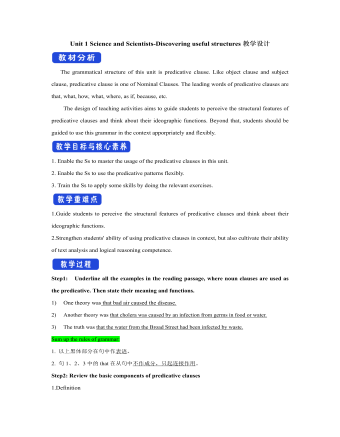
新人教版高中英语选修2Unit 1 Science and Scientists-Discovering useful structures教学设计
The grammatical structure of this unit is predicative clause. Like object clause and subject clause, predicative clause is one of Nominal Clauses. The leading words of predicative clauses are that, what, how, what, where, as if, because, etc.The design of teaching activities aims to guide students to perceive the structural features of predicative clauses and think about their ideographic functions. Beyond that, students should be guided to use this grammar in the context apporpriately and flexibly.1. Enable the Ss to master the usage of the predicative clauses in this unit.2. Enable the Ss to use the predicative patterns flexibly.3. Train the Ss to apply some skills by doing the relevant exercises.1.Guide students to perceive the structural features of predicative clauses and think about their ideographic functions.2.Strengthen students' ability of using predicative clauses in context, but also cultivate their ability of text analysis and logical reasoning competence.Step1: Underline all the examples in the reading passage, where noun clauses are used as the predicative. Then state their meaning and functions.1) One theory was that bad air caused the disease.2) Another theory was that cholera was caused by an infection from germs in food or water.3) The truth was that the water from the Broad Street had been infected by waste.Sum up the rules of grammar:1. 以上黑体部分在句中作表语。2. 句1、2、3中的that在从句中不作成分,只起连接作用。 Step2: Review the basic components of predicative clauses1.Definition
